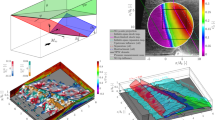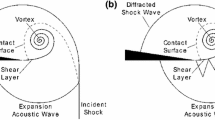Abstract
Strut-support interference effects were investigated at a nominal Mach number of 6. Cylinder and rhombus models are used; moreover, models called half shock-bump (SB) and SB applied to the front and both sides of the shock-bump shape are used. This is beneficial for free-stream flow recovery around the model surface by bumping the compression and expansion waves at a unit Reynolds number of approximately \(17.8 \times 10^{3}/\hbox {m}\) and a total enthalpy of approximately 1.9 MJ/kg. A quantitative density field analysis is conducted using the background-oriented schlieren technique, which is validated by measuring the shock stand-off distance and density increase rate on a hemisphere model. In this study, flow interference is divided into the measurements of the recompression shock zone thickness as a wake interference and the free-stream flow density recovery beyond the oblique shock as a strut interference. In the SB model, the thickness of the recompression shock zone is approximately 4.4 ± 0.2 mm, which is a reduction of approximately 53% compared with the cylinder model. In the oblique shock wave height measurements, defined by measuring the intersection of the increasing and decreasing points of density, the SB model shows a height of 16.4 mm, which is approximately 33.6% less than the 24.7 mm height of the cylinder model. In addition, the free-stream flow density beyond the oblique shock wave in the SB model is found to have an approximately 10% deviation from the free-stream density of 0.016 \(\hbox {kg/m}^{3}\), which is more effective than the 106% higher value in the cylinder model. Through such studies of flow interference, the effect of the SB shape on the strut-support is verified.
Graphic abstract

















Similar content being viewed by others
References
Altstatt MC, Dietz WE Jr (1978) Support interference on an ogive-cylinder model at high angle of attack in transonic flow. Technical report, Arnold Engineering Development Center, Tennessee
Ashill PR, Fulker JL, Hackett KC (2005) A review of recent developments in flow control. Aeronaut J 109(1095):205–232
Bannink WJ, Houtman EM, Bakker PG (1998) Base flow/underexpanded exhaust plume interaction in a supersonic external flow. In: 8th AIAA international space planes and hypersonic systems and technologies conference, pp 500–510
Beermann R, Quentin L, Pösch A, Reithmeier E, Kästner M (2017) Background oriented schlieren measurement of the refractive index field of air induced by a hot. Cylind Measur Object Appl Opt 56(14):4168–4179
Bogdonoff SM (1952) A preliminary study of Reynolds number effects on base pressure at M = 2.95. J Aeronaut Sci 19(3):201–206
Boger RC, Rosenbaum H, Reeves BL (1972) Flowfield interactions induced by underexpanded exhaust plumes. AIAA J 10(3):300–306
Canning TN, Nielsen JN (1980) The influence of sting and strut supports on the aerodynamic loads on an ogive cylinder at high angles of attack at transonic speeds. Technical report, Air Force Armament Laboratory, Flolida
Cartieri A, Mouton S, Boyet G (2010) Study of support interference effects at S1MA wind tunnel within the “SAO” project. 27th international congress of the aeronautical sciences, pp 1082–1091
Chapman DR (1951) An analysis of base pressure at supersonic velocities and comparison with experiment. Technical report, National Advisory Committee for Aeronautics, Washington
Cheung TM, Schrijer FFJ, Park G (2016) Nitrogen catalytic recombination on copper oxide in tertiary gas mixtures. J Spacecr Rockets 53(4):644–653
Choi U, Lee J, Song H, Sung T, Park G, Ahn J (2018) A study on adaptive design of experiment for sequential free-fall experiments in a shock tunnel. J Korean Soc Aeronaut Space Sci 46(10):798–805
Dalziel SB, Hughes GO, Sutherland BR (2000) Whole-field density measurements by ’synthetic schlieren’. Exp Fluids 28(4):322–335
Deepak NR, Gai SL, Neely AJ (2012) High-enthalpy flow over a rearward-facing step—a computational study. J Fluid Mech 695(1):405–438
Deng F, Qin N, Liu X, Yu X, Zhao N (2013) Shock control bump optimization for a low sweep supercritical wing. Sci China Technol Sc 56(10):2385–2390
Desikan SLN, Suresh K, Saravanan R, Patil MM, Balasubramanian P, Prasath M (2016) Effect of freestream–plume interaction on launch vehicle aerodynamics. J Spacecr Rockets 53(2):354–369
Dietz WE Jr, Altstatt MC (1979) Experimental investigation of support interference on an ogive cylinder at high incidence. J Spacecr Rockets 16(2):67–68
Dix RE (1976) Influences of sting support on aerodynamic loads acting on captive store models. Technical report, Arnold Engineering Development Center, Tennessee
Doig G, Bogdan G, Kabir KR, Snyder MR (2015) Reducing transonic wind tunnel sting interference effects for concealed store release testing. J Aerosp Eng 230(7):1284–1298
Elsinga GE, Van Oudheusden BW, Scarano F, Watt DW (2004) Assessment and application of quantitative schlieren methods: calibrated color schlieren and background oriented schlieren. Exp Fluids 36(2):309–325
Fleming JL, Simpson RL, Cowling JE, Devenport WJ (1993) An experimental study of a turbulent wing-body junction and wake flow. Exp Fluids 14:366–378
Gladstone JH, Dale TP (1863) Researches on the refraction, dispersion, and sensitiveness of liquids. Philos Trans R Soc London 153:317–343
Glawe DD, Donbar JM, Nejad AS, Sekar B, Chen TH, Samimy M, Driscoll JF (1994) Parallel fuel injection from the base of an extended strut into supersonic flow. In: 32nd aerospace sciences meeting and exhibit, pp 1–12
Hargather MJ, Settles GS (2010) Natural-background-oriented schlieren imaging. Exp Fluids 48(1):59–68
Harker M, O’Leary P (2008) Least squares surface reconstruction from measured gradient fields. In: 2008 IEEE conference on computer vision and pattern recognition, pp 1–7
Harker M, O’Leary P (2011) Least squares surface reconstruction from gradients: direct algebraic methods with spectral, Tikhonov, and constrained regularization. In: 2011 IEEE conference on computer vision and pattern recognition, pp 2529–2536
Harker M, O’Leary P (2013) Direct regularized surface reconstruction from gradients for industrial photometric stereo. Comput Ind 64(9):1221–1228
Hetherington B, Sims-Williams D B (2004) Wind tunnel model support strut interference. In: 2004 SAE world congress, Society of Automotive Engineers
Hetherington B, Sims-Williams D B (2006) Support strut interference effects on passenger and racing car wind tunnel models. In: 2006 SAE world congress, Society of Automotive Engineers
Jaffe P (1975) A free-flight investigation of transonic sting interference. Technical report, National Aeronautics and Space Administration, California
Jirásek A, Cummings RM (2010) Assessment of sting effect on X-31 aircraft model using CFD. In: 48th AIAA aerospace sciences meeting including the New Horizons Forum and Aerospace Exposition
Jo SM, Shim H, Park G, Kwon OJ, Kim JG (2019) Temperature determination in a shock tube using hydroxyl radical A-X band emission. Phys Fluids 31(2):026109
Kim I, Park G (2019) Experimental study of oxygen catalytic recombination on a smooth surface in a shock tube. Appl Therm Eng 156:678–691
Kim I, Lee S, Park G, Lee JK (2017) Overview of flow diagnosis in a shock tunnel. Int J Aeronaut Space 18(3):425–435
Kim I, Park G, Na JJ (2019) Experimental study of surface roughness effect on oxygen catalytic recombination. Int J Heat Mass Transf 138:916–922
Lamb JP, Oberkampf WL (1993) A review and development of correlations for base pressure and base heating in supersonic flow. Technical report, Sandia National Laboratories, California
Lee DS, Periaux J, Srinivas K, Gonzalez LF, Qin N, Onate E (2011) Shock control bump design optimization on natural laminar aerofoil. In: 6th international conference on computational fluid dynamics, pp 1–6
Lee S, Oh BS, Kim Y, Park G (2017a) A high-altitude environment simulation of space launch vehicle in a ground-test facility. J Korean Soc Aeronaut Space Sci 45(11):914–921
Lee S, Song H, Park G, Lee JK (2017b) Freefalling heated sphere in a shock tunnel. AIAA J 55(11):3995–3998
Lee S, Oh BS, Kim Y, Park G (2018) High-altitude environment simulation of space launch vehicle including a thruster module. J Korean Soc Aeronaut Space Sci 46(10):791–797
Li S, Liu D, Li Q (2015) The optimal design of a wind tunnel model sting system based on the CFD method. Int J Heat Technol 33(4):137–144
Liepmann HW, Roshko A (1957) Elements of gas dynamics, 1st edn. Wiley, New York
McGhee RJ (1970) Jet-plume-induced flow separation on a lifting entry body at mach numbers from 4.00 to 6.00. Technical report, National Aeronautics and Space Administration, Washington
Nallasamy R, Kandula M, Duncil L, Schallhorn P (2008) Numerical simulation of the base flow and heat transfer characteristics of a four-nozzle clustered rocket engine. In: 40th thermophysics conference, pp 1–28
Park G (2013) Oxygen catalytic recombination on copper oxide in tertiary gas mixtures. J Spacecr Rockets 50(3):540–555
Pick GS (1971) Sting effects in hypersonic base pressure measurements. Technical report, Naval Ship Research and Development Center, Maryland
Potter DF, Gollan RJ, Eichmann T, Jacobs PA, Morgan RG, Mclntyre TJ (2007) Simulation of \(\text{CO}_2\)–\(\text{N}_2\) expansion tunnel flow for the study of radiating bluntbody shock layers. In: 16th Australasian fluid mechanics conference, pp 373–380
Qin N, Zhu Y, Shaw ST (2004) Numerical study of active shock control for transonic aerodynamics. Int J Numer Methods Heat Fluid Flow 14(4):444–466
Richard H, Raffel M (2001) Principle and applications of the background oriented schlieren (BOS) method. Measure Sci Technol 12(9):1576–1585
Richard H, Raffel M, Rein M, Kompenhans J, Meier GEA (2000) Demonstration of the applicability of a background oriented schlieren (BOS) method. In: 10th international symposium on applications of laser techniques to fluid mechanics, pp 1–10
Rivers MB, Hunter CA (2012) Support System effects on the NASA common research model. In: 50th AIAA aerospace sciences meeting including the New Horizons Forum and Aerospace Exposition, pp 1–27
Rivers MB, Hunter CA, Gatlin GM (2009) Support system effects on the DLR-F6 transport configuration in the national transonic facility. In: 27th AIAA applied aerodynamics conference, American Institute of Aeronautics and Astronautics, pp 1–20
Russo S, Müller J, Paletta N, Adden S, Ruiz-Calavera LP (2018) Numerical prediction of the strut interference on a regional aircraft wind-tunnel model. In: 6th European conference on computational mechanics
Saile D, Gülhan A (2014) Plume-induced effect on the near-wake region of a generic space launcher geometry. In: 32nd AIAA applied aerodynamics conference, pp 1–13
Schiavetta LA, Boelens OJ, Fritz W, Cummings RM (2007) Sting effects on transonic delta wing experiments. In: 3rd international symposium on integrating CFD and experiments in aerodynamics, pp 1–17
Serbin H (1958) Supersonic flow around blunt bodies. J Aerosp Sci 25(1):58–59
Simpson RL (2001) Junction flows. Annu Rev Fluid Mech 33:415–443
Song H, Lee S, Lee JK, Park G (2017) Attitude angle and drag coefficient measurements of free-falling hemisphere using a visualization technique. J Korean Soc Aeronaut Space Sci 45(8):619–626
Stephan S, Wu J, Radespiel R (2015) Propulsive jet influence on generic launcher base flow. CEAS J 7(4):453–473
Stivers LS Jr, Levy LL Jr (1961) Effects of sting-support diameter on the base pressure of an elliptic cone at Mach numbers from 0.60 to 1.40. Technical report, National Aeronautics and Space Administration, Washington
Tunnell PJ (1955) An investigation of sting-support interference on base pressure and forebody chord force at Mach numbers from 0.60 to 1.30. Technical report, National Advisory Committee for Aeronautics, Washington
Venkatakrishnan L, Meier GE (2004) Density measurements using the background oriented schlieren technique. Exp Fluids 37(2):237–247
Acknowledgements
This work was supported by the Korea Space Launch Vehicle (KSLV-II) funded by the Ministry of Science, Information and Communications Technology, and Future Planning (MSIP) (No. 2016M1A3A1A02021183), and by Basic Science Research Program through the National Research Foundation of Korea (NRF) funded by the Ministry of Education (No. 2018R1A6A3A01010886).
Author information
Authors and Affiliations
Corresponding author
Additional information
Publisher's Note
Springer Nature remains neutral with regard to jurisdictional claims in published maps and institutional affiliations.
Sungmin Lee is currently Postdoctoral fellow at Korea Aerospace Research Institute (KARI).
Rights and permissions
About this article
Cite this article
Lee, S., Song, H. & Park, G. Study of strut interference in high-speed flows. Exp Fluids 61, 105 (2020). https://doi.org/10.1007/s00348-020-2934-8
Received:
Revised:
Accepted:
Published:
DOI: https://doi.org/10.1007/s00348-020-2934-8




